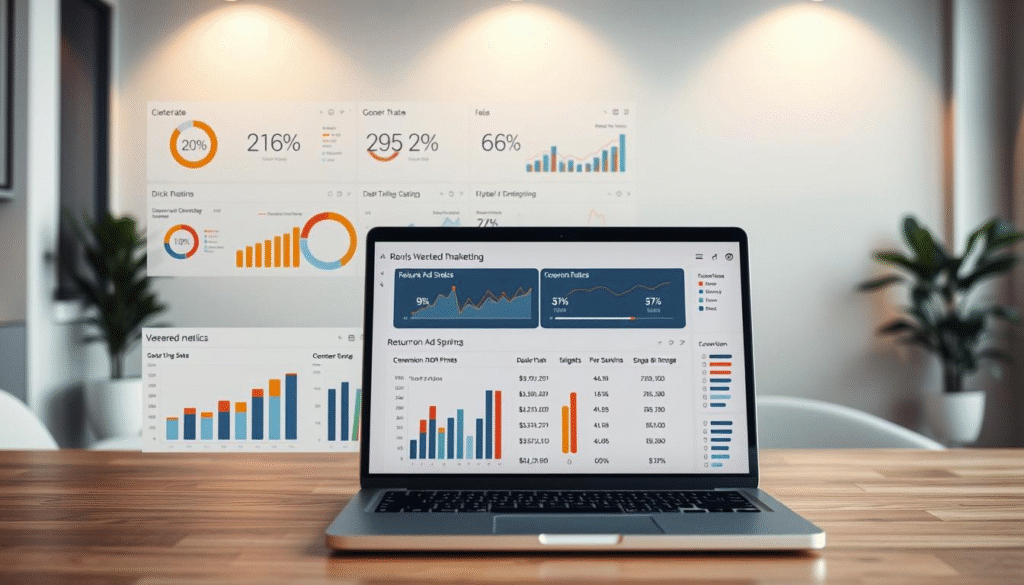Did you know that search engine marketing campaigns can increase online visibility by up to 300% for businesses?
This amazing fact shows how key SEM is in digital marketing. By using search engine marketing, companies can greatly improve their online presence. This leads to more traffic and sales.

Good SEM means making ads that show up on search engines. This lets businesses reach people who are looking for what they offer.
Key Takeaways
- SEM can boost online visibility for businesses.
- Targeted ads are key for effective SEM.
- SEM can help drive more traffic and sales.
- SEM is a vital part of digital marketing strategies.
- Using the right SEM techniques can greatly improve online presence.
What Are SEM Campaigns and Why They Matter
In today’s digital world, SEM campaigns are key for businesses to reach their audience. SEM boosts a brand’s online presence and drives traffic with paid ads.
Definition and Core Components
SEM promotes websites through ads on search engines like Google. It includes keyword research, ad writing, and managing bids. A good SEM strategy shows ads to users searching for specific terms.
The Difference Between SEM and SEO
SEM and SEO both aim to boost website visibility, but differently. SEO uses content to improve organic search rankings. SEM uses paid ads for top spots. A study shows combining both can increase visibility by up to 50%.
Business Impact of Effective SEM
Good SEM campaigns offer quick results, targeted ads, and clear ROI. Google reports that for every $1 spent on Google Ads, businesses get $2 in revenue. This shows the value of a well-planned SEM strategy.
| SEM Benefits | Description | Impact |
| Increased Visibility | Prominent ad placements on search engines | Higher brand awareness |
| Targeted Advertising | Ads are shown to users searching for specific keywords | Better conversion rates |
| Measurable ROI | Track the performance of SEM campaigns | Data-driven decision making |
A digital marketing expert notes, “SEM is a strong tool for driving traffic and conversions. By using SEM wisely, businesses can outdo their rivals.”
Evaluating Popular SEM Campaign Platforms
The world of SEM campaigns is filled with a few top players. Advertisers have many choices for paid search and online ads. They must pick the best platform for their needs.
Google Ads
Google Ads is a top choice for SEM campaigns. It offers a wide reach and many ways to target ads.
Overview
Google Ads uses a pay-per-click model. Advertisers bid on keywords that fit their business.
Pros
- Extensive Reach: Google is the most used search engine, giving great exposure.
- Advanced Targeting: You can target by keyword, location, and more.
Cons
- High Competition: Popular keywords can be pricey because of the competition.
- Complexity: Running campaigns can be hard, even for experts.
Features
Google Ads has many features. These include ad extensions, conversion tracking, and automated bidding.
Microsoft Advertising (Bing Ads)
Microsoft Advertising, once Bing Ads, is a big name in SEM.
Overview
It has a similar model to Google Ads but might be cheaper because of less competition.
Pros
- Lower Costs: With less competition, costs can be lower.
- Integration: It works well with Microsoft products.
Cons
- Smaller Audience: Bing has fewer users than Google.
- Limited Features: Some features are not as advanced as Google’s.
Features
Microsoft Advertising has ad extensions and conversion tracking. But, it doesn’t have as many features as Google Ads.
Facebook Ads for SEM
Facebook Ads is great for SEM, focusing on social media ads.
Overview
It lets you target ads based on demographics, interests, and behaviors.
Pros
- Targeting Capabilities: You can target very precisely.
- Visual Impact: Visual ads can grab attention.
Cons
- Click-Through Rates: CTR might be lower than search ads.
- Conversion Tracking: Tracking conversions from Facebook Ads can be tough.
Features
Facebook Ads has many features. These include different ad formats and detailed analytics.
The Anatomy of Successful SEM Campaigns
Effective SEM campaigns start with clear goals and precise targeting. To succeed in digital ads, businesses need to know the key parts of SEM strategy.
Setting Clear Campaign Objectives
Clear goals are the foundation of a successful SEM campaign. By setting specific, measurable targets, businesses can focus better and use resources wisely. Goals might be to increase website visits, get more leads, or boost sales.
Key considerations for setting campaign objectives:
- Align objectives with overall business goals
- Establish measurable KPIs to track progress
- Set realistic targets based on historical data
Audience Targeting Precision
Getting your audience right is key for SEM success. Knowing who your audience is helps create ads that speak to them. This makes ads more effective.
Audience targeting strategies include:
- Demographic targeting (age, gender, location)
- Interest-based targeting
- Behavioral targeting
Budget Allocation Strategies
Smart budgeting is essential for SEM success. Businesses should spread their budget across campaigns, ad groups, and keywords to get the best return.
| Budget Allocation Strategy | Description | Benefits |
| Daily Budgeting | Allocate a daily budget to campaigns | Ensures consistent ad visibility |
| Keyword-Level Budgeting | Assign budget to high-performing keywords | Maximizes ROI on profitable keywords |
| Campaign-Level Budgeting | Distribute budget across multiple campaigns | Allows for campaign prioritization |
Campaign Structure Best Practices
A well-organized campaign is key to SEM success. This means grouping campaigns logically, using the right keywords, and making compelling ads.
By following these tips, businesses can make their SEM campaigns more effective. This helps reach digital advertising goals.
Advanced Keyword Research Techniques
Keyword research in SEM is more than just finding words. It’s about understanding what people want to find. “Knowing your audience’s language is key in SEM,” experts say. This shows how important it is to do keyword research well.
Finding High-Intent Keywords
High-intent keywords show a user’s plan to buy or use a service. Finding these keywords means looking at search trends, how people act, and what competitors do.
Competitor Keyword Analysis
Looking at what competitors use can reveal market chances. By seeing what works for others, businesses can improve their keyword plans and stand out.
Long-Tail Keywords Strategy
Long-tail keywords are great for reaching specific groups. Using a long-tail keyword strategy can boost sales because it targets the right people.
Negative Keywords Implementation
Negative keywords help keep unwanted visitors away. By using them, businesses can increase their campaign’s return on investment by showing ads to the right people.
As
“The right keywords can make or break your SEM campaign”
, showing how vital advanced keyword research is for SEM success.
Crafting Compelling Ad Copy That Converts
Effective SEM optimization begins with ad copy that speaks to your audience. It’s a mix of creativity and data-driven insights.
Writing Headlines That Grab Attention
The headline grabs the first glance. Use action words and include key terms to stand out.
Creating Effective Descriptions
Descriptions should be clear and to the point. Emphasize what makes your product unique to grab attention.
Call-to-Action Best Practices
A good call-to-action (CTA) gets users to act. Try using CTAs like “Sign Up Now” or “Get Started Today” to encourage action.
Ad Extensions Utilization
Ad extensions add more info and boost visibility. Use site links, callouts, and structured snippets to entice clicks.
| Ad Copy Element | Best Practice | Example |
| Headline | Use action-oriented language | “Discover the Best SEM Tips” |
| Description | Highlight unique selling points | “Improve your SEM campaigns with our expert strategies.” |
| Call-to-Action | Prompt immediate response | “Sign Up Now and Boost Your SEM” |
Landing Page Optimization for SEM Success
To get the most out of your SEM campaigns, focus on landing page optimization. A well-optimized landing page turns ad traffic into real results like sales or sign-ups. It’s all about achieving your desired actions.
Aligning Landing Pages with Ad Messaging
It’s vital to make sure your landing pages match your ad messaging. The message and tone of your ads should be the same on your landing page. This creates a smooth user experience. Consistency builds trust and boosts conversion chances.

Conversion-Focused Design Elements
Your landing page should aim for one thing: conversion. Use design elements that draw the user’s focus to the action you want them to take. This includes a clear call-to-action (CTA) button and content that speaks to the user’s needs.
Mobile Optimization Essentials
Most people use mobile devices to access websites. So, making your landing pages mobile-friendly is a must. They should load quickly, be easy to navigate, and work well on all screen sizes.
A/B Testing Strategies
A/B testing, or split testing, is key for landing page optimization. It lets you see which versions of your page work best. This way, you can make changes based on data to boost your conversion rates. Regular testing helps keep improving your landing page.
By focusing on these landing page optimization areas, you can greatly improve your SEM campaigns. This leads to higher conversion rates and a better return on investment.
Bidding Strategies and Budget Management
In the world of SEM, bidding strategies and budget management are key to success. Managing these well can greatly improve your campaign’s return on investment (ROI).
Manual vs. Automated Bidding
Choosing between manual and automated bidding is a big decision. Manual bidding lets you control and adjust bids closely. It’s great for precise control. Automated bidding, on the other hand, uses smart algorithms to set bids automatically. This can make your campaigns more efficient.
Budget Distribution Across Campaigns
Spreading your budget right across campaigns is vital for the best ROI. You need to watch how each campaign does and adjust your budget. Experts say, “Distributing budget well across campaigns is key to SEM success.”
“The key to successful budget distribution lies in continuous monitoring and adjustment of campaign performance.”
Industry Expert
Bid Adjustments for Maximum ROI
Bid adjustments are essential for better campaign performance. By tweaking bids for different devices, locations, and times, you can boost your ROI. For example, raising bids for top-performing devices or areas can help your campaign stand out.
Seasonal and Time-Based Bidding
Seasonal and time-based bidding means changing bids with the seasons or at certain times. It’s a smart way to make the most of busy times and cut costs when it’s slow.
Measuring SEM Campaign Performance
Understanding your SEM campaign’s performance is key to making them better and more profitable. You need to track important KPIs, know how to use attribution models, and use reporting tools. Also, analyzing your competitors can help a lot.
Essential KPIs to Track
To measure your SEM campaign’s success, you must track the right KPIs. These are:
- Click-through Rate (CTR)
- Conversion Rate
- Cost Per Conversion (CPC)
- Return on Ad Spend (ROAS)
By tracking these KPIs, you can see what’s working and what’s not.
Attribution Models Explained
Attribution models help figure out how each touchpoint leads to a conversion. There are a few common ones:
| Attribution Model | Description |
| Last Click | Attributes conversion to the last click |
| First Click | Attributes conversion to the first click |
| Linear | Attributes conversion equally across all clicks |
Reporting Tools and Dashboards
Choosing the right reporting tools and dashboards is important for analyzing your campaigns. Google Ads and Microsoft Advertising offer detailed insights into your campaign’s performance.

Analyzing Competitor Performance
Looking at how your competitors do can give you great insights. It helps you see market trends and find ways to improve your SEM campaigns.
Common SEM Campaign Mistakes to Avoid
To get the most out of your SEM campaigns, it’s key to steer clear of common mistakes. Knowing and avoiding these errors can greatly boost your campaign’s success. This way, you can reach your marketing goals more effectively.
Poor Account Structure
A well-organized account structure is essential for SEM campaign success. It makes management easier, tracking better, and targeting more precise. Without it, you might face confusion, wasted budget, and missed chances.
- Group related keywords together
- Create ad groups that are tightly themed
- Ensure landing pages are relevant to ad copy
Ignoring Quality Score
Quality Score is a vital metric in SEM campaigns. It affects ad positioning and cost-per-click. Ignoring it can increase costs and lower ad visibility.
Tips to improve Quality Score:
| Factor | Impact | Improvement Strategy |
| Ad Relevance | High relevance improves score | Ensure ad copy is closely related to keywords |
| Landing Page Experience | Relevant, user-friendly pages boost score | Optimize landing pages for user experience and relevance |
| Expected CTR | Higher CTR expectations improve score | Use compelling ad copy to increase CTR |
Neglecting Ad Testing
Ad testing is key to finding the best ad variations. Skipping it can mean missing out on chances to improve and lower conversion rates.
Best practices for ad testing include:
- Testing multiple ad variations
- Focusing on a single variable per test
- Allowing tests to run until statistically significant results are achieved
Overlooking Geographic Targeting
Geographic targeting helps focus efforts on specific areas, making campaigns more efficient. Ignoring it can waste budget on clicks that don’t convert.
Considerations for geographic targeting:
- Identify regions with high conversion rates
- Adjust bids based on geographic performance
- Exclude regions with low or negative ROI
Who Should Invest in SEM Campaigns: Business Recommendations
In today’s digital world, SEM campaigns are key for businesses wanting to reach their audience well. With the right plan, businesses can grow a lot and get more seen online.
Small Business Considerations
Small businesses find SEM campaigns very helpful. They can use specific keywords and target groups to compete with big companies. It’s key for small businesses to focus on local SEO to get the best results.
Enterprise-Level Strategy
Big companies also gain from SEM campaigns with a detailed plan. They should use advanced SEM services like remarketing and custom audience targeting to boost their ads.
Industry-Specific Recommendations
Each industry has its own SEM needs. For example:
- E-commerce sites should use product-specific keywords and shopping ads.
- Service-based businesses should aim for long-tail keywords that match their services.
- B2B companies should use industry terms and target decision-makers.
Budget Requirements by Business Size
The cost for SEM campaigns changes a lot based on size and industry. Here’s a rough guide:
| Business Size | Recommended Budget |
| Small Business | $500-$2,000 per month |
| Medium Business | $2,000-$5,000 per month |
| Large Enterprise | $5,000-$20,000+ per month |
By knowing these business recommendations and adjusting their SEM strategy, businesses can get the most out of their investment. This helps them meet their marketing goals.

Conclusion
In summary, SEM campaigns are a great way for businesses to get more online visibility. We’ve looked at the basics and advanced strategies for improving your online presence.
Creating a good SEM strategy means planning well, targeting the right audience, and always improving. Using the best SEM platforms and methods can help businesses get a big return on investment and meet their marketing targets.
| Key Elements | Description | Importance |
| Campaign Objectives | Clear goals for SEM campaigns | High |
| Audience Targeting | Precision in targeting the desired audience | High |
| Budget Allocation | Strategic distribution of budget across campaigns | Medium |
When you start your SEM campaigns, keep a close eye on how they’re doing. Make changes as needed. With the right plan, search engine marketing campaigns can really help your business grow.
Sources
To make your SEM campaigns better, using the right tools is key. Many platforms give you insights and features to boost your marketing. This helps a lot in optimizing your search engine marketing.
SEM resources like HubSpot have great guides and tools for better campaigns. SEMrush also helps with keyword analysis and checking out your competitors.
Google Trends is a must for keeping up with the latest topics and keywords. These SEM tools give you data to make your campaigns stronger.
Using these resources can help you improve your SEM strategies. This way, you can get better results. Check out these options to find the best tools for your campaigns.
FAQ
What is the primary goal of a Search Engine Marketing (SEM) campaign?
The main goal of an SEM campaign is to boost a business’s online presence. It aims to attract more targeted traffic and increase conversions. This is done through paid search ads on search engines like Google.
How does SEM differ from Search Engine Optimization (SEO)?
SEM is about paid ads on search engines. SEO, on the other hand, focuses on improving website content to rank better in search results. SEO is a long-term strategy, while SEM offers quick results.
What are the key components of a successful SEM campaign?
A winning SEM campaign starts with clear goals and targets the right audience. It also needs a smart budget plan and a focus on ROI. Ad copy, keywords, and landing pages must be continuously improved.
Which SEM campaign platforms are most effective for businesses?
Top SEM platforms include Google Ads, Microsoft Advertising, and Facebook Ads. The best choice for a business depends on its needs, audience, and industry.
How can businesses optimize their SEM campaigns for better ROI?
To boost ROI, businesses should use advanced keyword research and write compelling ad copy. They should also optimize landing pages and manage their budgets wisely.
What is the importance of Quality Score in SEM campaigns?
Quality Score is a Google Ads metric for ad and keyword quality. A higher score means lower costs and better ad placement.
How can businesses measure the performance of their SEM campaigns?
Businesses can track KPIs like click-through rate and conversion rate. They can also use reporting tools to see how well their campaigns are doing.
What are some common mistakes to avoid in SEM campaigns?
Avoid poor account structure and ignore Quality Score. Don’t neglect ad testing and overlook geographic targeting. These mistakes can harm campaign success and waste budget.
Who should invest in SEM campaigns?
All businesses can benefit from SEM campaigns. It’s suitable for businesses of all sizes, depending on their industry, audience, and budget. Small businesses can level the playing field, while big ones can scale their marketing.
What budget requirements are typically needed for SEM campaigns?
SEM budgets vary by business size, industry, and goals. Small businesses might start with a few hundred dollars monthly. Larger ones need more to meet their marketing targets.
